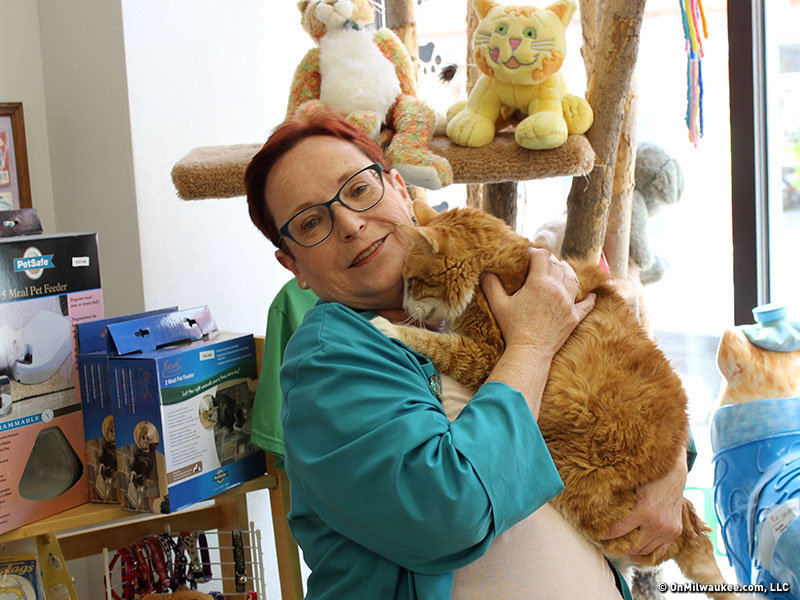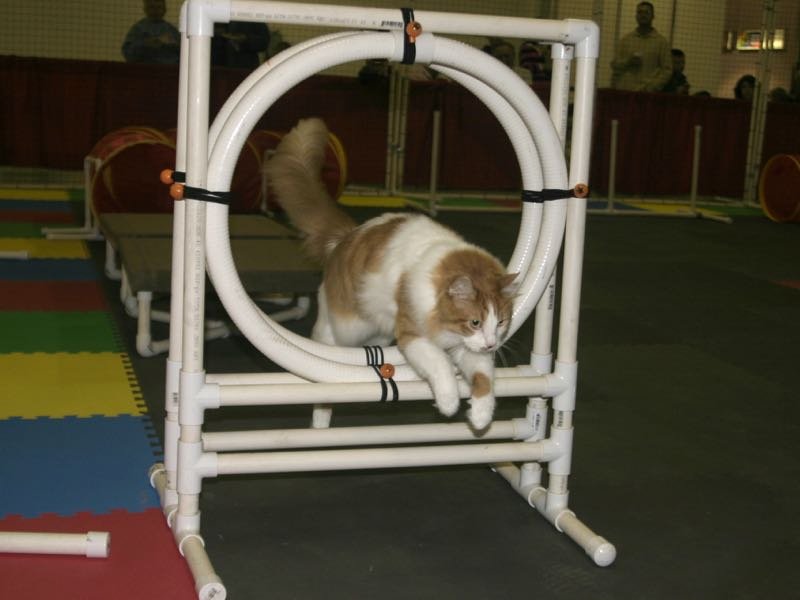Welcome to OnMeowaukee Cat Week, a meowsome bunch of articles, photos, videos and an Instagram contest celebrating all aspects of Milwaukee cats. Sponsored by Bark N' Scratch Outpost, these seven days are dedicated to those creatures with nine lives who make our lives more paw-sitive.
Humans aren’t the only mammals who benefit from high quality proteins. Just ask Stacy La Point, owner of Fresh is Best.
If someone told you that simply changing your cat’s pet food could result in weight loss, reduced allergy symptoms, alleviation of asthma, higher energy levels, a shinier coat and an overall increase in health, would you believe them?
It’s a message Stacy La Point, owner of Milwaukee-based pet food company Fresh is Best, has been preaching for over fifteen years – ever since a protein rich diet saved the life of her beloved pet, a 6-year-old German Shepherd.
"Jade was the love of my life at the time," La Point recalls. "And when I graduated from UWM with my art degree, she was the first pet I adopted. So, when she was diagnosed with Addison’s Disease, I was really devastated. I knew I needed to do whatever it took to help her get well."
La Point followed her veterinarian’s orders and began medicating Jade, hoping to slow the progress of the canine’s adrenal gland failure; but, she also began doing research on the internet to find out if there was anything more she could do.
"I stumbled upon an entire subculture," she says. "It was a community of people who were making their own pet food from scratch. And I started reading about what was in most commercial pet food. It was really eye opening."
She found that – in addition to the protein carnivorous pets like cats and dogs need – most commercial foods also contained numerous fillers, including corn, wheat, soy and legume products. And her perspective on everything she had come to know about caring for her pets was tipped on end.
"A lot of food is created with a lot of fillers and grains, waste products from the human food system," says La Point. "And those ingredients can actually cause, or exacerbate health issues in pets."
La Point decided to make some changes, to see if it would help Jade’s health. For one, she started making Jade’s food from raw, high quality proteins. The results were dramatic.
"I literally noticed a difference in her health right away," she recalls.
Beginnings
As Jade’s health improved, La Point says her homemade dog food captured the attention of friends and family, all of whom wanted her to make food for their pets.
"Ultimately, you can only make so much pet food in your kitchen," she says. "So, by 2001, I found myself starting an LLC so that I could sell the pet food I’d been making."
La Point partnered with an animal nutritionist, who helped her to create protein-based raw pet foods that met the requirements of the Association of Animal Feed Control Officials. And the company now known as Fresh is Best was born.
Today, La Point’s small company is approaching its 16-year anniversary. And La Point says she’s just as passionate about the food she makes as ever.
"I love pets so much," she says. "And they don’t have a choice in what they eat, so it makes sense that we make good decisions for them. For me, that is really what keeps me motivated."

High quality species appropriate food
La Point says her Fresh is Best cat food tries its best to meet cats exactly where they want to be, nutritionally.
"I believe in feeding pets what they are made to eat – what they would eat if they were living in the wild. Cats are used to eating meat like rabbits, birds, mice," she notes. "We can’t imitate their natural diet quite that closely. But, we can give them what they need through other protein sources like beef and chicken."
Fresh is Best focuses on high quality, USDA inspected, human grade proteins, including grassfed beef, chicken and turkey.
"We’re very thoughtful about where we source our meats," notes La Point, "And we try to get ingredients that satisfy both the animal lover and the pet."
La Point says her goal with Fresh is Best is to give people the best possible commercial food she can make, with quality that competed with homemade.
"It’s one of the reasons why we only sell our products at small, independently owned pet stores and boutiques where the people care about what they’re selling," she says. "We don’t even use distributors. We ship directly to stores. After all, if fresh is truly best, then we don’t want to be warehousing our inventory."
Fresh is best is available in two forms – frozen or freeze dried – and each flavor contains fresh meat, vegetables and vitamin and mineral supplements, making them a complete, balanced diet.
According to La Point, each 8-ounce bag of freeze-dried food contains approximately two pounds of raw pet food before moisture is removed and provides about 16 meals for the average 10-pound housecat. La Point says that, on average, the cost to feed a cat her product averages out to about $2 per day.
Transitioning your cat
La Point says she encourages cat owners to try out a raw diet to see the difference it makes for their pets.
"The difference will be most dramatic in middle aged pets who are already showing signs of declining health," she notes. "A raw diet for six months should be enough for someone to see differences, including weight loss, allergy relief and an overall improvement in the health and appearance of the pet."
La Point notes that, if a cat or dog is truly responding to the food, the owner may note a "healing crisis," symptoms which would seem to indicate a decline in health, but are really just manifestations of the detoxification the pet is experiencing as it is, "ridding itself of all the junk stored in their tissues."
But, it’s not a cause for worry.
"Once you make it through that phase," she notes. "The benefits will follow."
If you’re thinking about transitioning your cat over to Fresh is Best, or another high quality food, La Point says it’s not always easy, but it’s always worth your while.
"Cats are definitely particular," she notes. "And they can be addicted to a particular product – especially low quality foods that contain propalyne glycol or rendered fat products – so, it can take a while to transition."
She suggests using the following techniques to help ease the transition:
- Mix the foods: Begin by mixing Fresh is Best freeze dried food with some of the cat’s old food. "You can put down a dish of rehydrated food and some cats will just dive right in," she notes. "Others may need a transitional period."
- Take advantage of hunger: Make sure your cat is actually hungry when you introduce a new food. That will ensure they’re more likely to eat it.
- Get on a schedule: If your cat is a "free-feeder" (meaning it can eat from a bowl of food at will all day long), La Point suggests switching over to scheduled feedings. "Cats are motivated by hunger – so free feeding isn’t natural," she says. "And some will eat out of boredom, making them gain weight."
- Be persistent: "If you can get your cat to eat this food twice a day, it will lose weight and balance out," says La Point. "You may hear a lot of screaming and crying during the transition, but you are almost guaranteed to see a difference."
- Most of all, stay positive: "I would say that I’ve never heard of a cat who couldn’t be switched," La Point says.
If you feel that an all-out change isn't something you can handle right now, La Point says that simply switching over to a grain-free formula is a good first step. She notes that the best foods are raw – fresh, frozen or freeze dried. The second best option is canned food, which is high in both moisture and protein. Grain free dried foods fall third on her list.
A full list of Wisconsin retailers who carry Fresh is Best is available on the company's web site.
As a passionate champion of the local dining scene, Lori has reimagined the restaurant critic's role into that of a trusted dining concierge, guiding food lovers to delightful culinary discoveries and memorable experiences.
Lori is an avid cook whose accrual of condiments and spices is rivaled only by her cookbook collection. Her passion for the culinary industry was birthed while balancing A&W root beer mugs as a teenage carhop, fed by insatiable curiosity and fueled by the people whose stories entwine with every dish. Lori is the author of two books: the "Wisconsin Field to Fork" cookbook and "Milwaukee Food". Her work has garnered journalism awards from entities including the Milwaukee Press Club. In 2024, Lori was honored with a "Top 20 Women in Hospitality to Watch" award by the Wisconsin Restaurant Association.
When she’s not eating, photographing food, writing or planning for TV and radio spots, you’ll find Lori seeking out adventures with her husband Paul, traveling, cooking, reading, learning, snuggling with her cats and looking for ways to make a difference.







